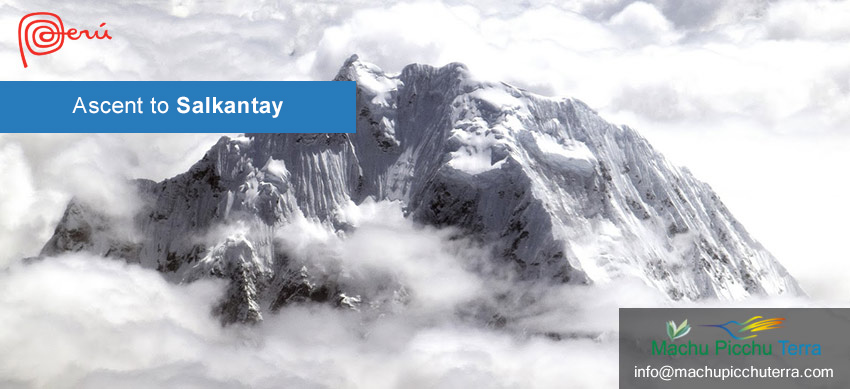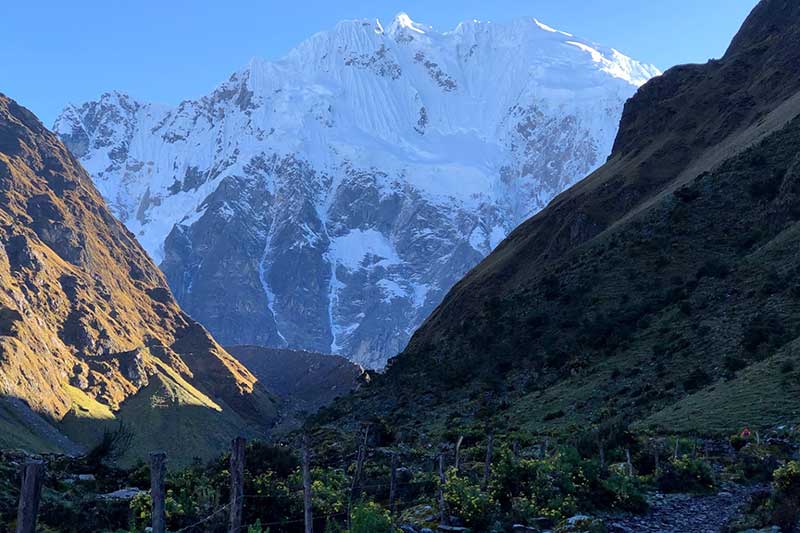
In Peru, you can climb mountains and snow-capped peaks that easily exceed 6,000 meters in altitude. One of these incredible and inaccessible destinations is located in Cusco. Located right in the Vilcabamba Mountain range lies the snow-capped mountain of Salkantay. It is one of the most important mountains because it can supply water to lakes and rivers through thaws. Likewise, the high jungle needs to have a humid climate throughout the year and it is also one of the main routes for lovers of hiking trails. Being the Salkantay Trek the most popular tour of this snowy mountain. However, in this blog, we want to talk exclusively about what this mountain is like.
Location of the Salkantay snow-capped mountain
This beautiful snow-capped mountain is located very close to Cusco, exactly 60 kilometers away. There are many ways to reach its slopes, but the most convenient is by car. During several tours in Cusco, you can visit this place. However, the most popular is the one that makes a route to Machu Picchu. This tour is known as the Salkantay Trek and has a minimum duration of 4 days and can extend up to 6 days, doing more activities in the mountain. To get to Machu Picchu by this mountain you have to climb part of it, and then go into the high jungle of Cusco.
Another tour that is also popular and relatively easy to do is the Laguna Humantay Tour. This tour allows you to visit one of the most beautiful lagoons in all of Peru and at the same time contemplate part of the Salkantay snow-capped mountain. The snowy Salkantay is surrounded by beautiful lagoons, Humantay, is one of them and the most popular. The rest of them are bordering part of its other slopes. While others can only be seen by those who dare to climb to the top of this mountain.
The snowy Salkantay has an altitude of 6271 meters above sea level. This is from the highest peak of the snow which can be reached. To get to the top you will have to have enough experience in mountaineering and do it with the company of an expert. One of the benefits of doing this feat is that you will be part of a select group that managed to reach the top of the most complicated mountains to climb. It is not for nothing that the name comes from the composition of two Quechua words “salqa” and “antay”, which can be translated as “wild mountain that produces landslides”. Where the first word would mean “wild, sullen”. While the second one means “avalanche or landslide producer”. Probably alludes to the legend of its origin, as we will see below.
Legend of the Salkantay snow-capped mountain

Panoramic view of Salkantay snow-capped mountain and Humantay Lake
Many legends narrate the beginning of the snowy Salkantay and by the oral tradition, they have probably suffered changes. However, the legend managed to reach these days. It is also possible that some references have changed. However, these myths are certainly a way to understand the Andean cosmogony and at the same time the importance of these places that continue to be sacred for a long time. The legend of the Salkantay is as follows:
Legend of the Salkantay snow-capped mountain
- Many years ago when the first Cusquenian people began to occupy these territories. One of the most bloody events occurred up to that time. A drought took hold of the entire valley and food became scarce and no crops could grow. Faced with this event, two brothers set out in search of fertile land or land containing animals or food.
- Both brothers set off in opposite directions. The older of them set out in a southerly direction where he reached an encounter with the Coya territories, managing to obtain food that he began to send to his dejected people. While the younger, Salkantay, had a different journey. He arrived to the north encountering a territory different from his own. The high jungle seemed impenetrable, to his luck, he met one of the princesses of the Anti people. They both fell in love and surrendered to the power of love.
- Faced with the impossibility of living their love because of the prohibition of the Anti curacas, this couple decided to escape. During the escape, the princess was wounded, and without caring about the loss of her daughter, the Anti’s chief curaca ordered her execution. Salkantay, not knowing what to do, surrendered to his captors, but when he saw that the princess was cruelly killed, he was filled with anger and killed all the captors in a bloody way. The result of this confrontation infuriated some divinities who decided to punish Salkantay.
- The place where he died was erected on a large mountain. It is said that sometimes it cries, and its tears form lakes and lagoons around it. It is her tears that give her turquoise tones, the main characteristic of her waters. Similarly, the princess, as a way to appease the suffering of Salkantay, was converted into another mountain and was known as Waynawillca and later as Veronica. It is also narrated that sometimes she cries for not being with her beloved. On the other hand, the brother Ausangate, before the suffering of his brother, asked to become a mountain to protect all the people so that the droughts would not be so strong in the coming years. Giving his life to accompany his brother and to take care of his people.
The function of the Vilcabamba mountain range

This is what the Salkantay looks like at the beginning of the ascent
The Vilcabamb Mountain rangea is one of the mountain ranges with the greatest variety of geographies. Its main characteristic is that it is crossed by the Vilcanota River and other rivers that end up joining the larger rivers that will flow into the sea. Through these valleys is where the Vilcabamb Mountain rangea extends, which has an approximate extension of 260 kilometers, just northwest of Cusco. Its beginning is one of the branches that has the Salkantay.
In this sense, the importance of this mountain range lies in the presence of the Salkantay and its extension which gives life and a suitable climate to all the high jungles of the place. This mountain range generates all the microclimates that can be found throughout the area, especially for the presence of canyons and valleys that cross part of the Apurimac Valley. In this chain, you can find different Inca constructions where the presence of Machu Picchu, Choquequirao, and the last Inca refuge will stand out.
Therefore, it can be said, that this mountain range, served for the resistance of the Manco Inca in Vilcabamba and managed to resist about 40 years, the Spanish attacks. Manco Inca managed to establish a whole citadel in a large part of this valley, where they left or abandoned some other citadels that would give meaning to why the Spaniards did not reach Machu Picchu and Choquequirao. According to some chronicles, the last Inca Tupac Amaru was possibly captured while trying to escape in the direction of Machu Picchu. Thus closing or eliminating a possible connection or arrival of the Spaniards to the current wonder of the world.
Today all the Inca trails that were built in this extensive mountain range that expands through the high jungle geography, were lost due to the abundant growth of the vegetation of the place. Also because the natives themselves decided to hide all the enclosures, as a form of moral resistance against the Spanish domination. Today there are only a few hiking trails that can be done as the Inca Trail to Machu Picchu. Luckily for some mountaineers. There are still stretches left by the Incas that lead to mountains considered sacred. This can be seen in the ascent to the snowy Salkantay, as we will see now.
If you decide to do the Salkantay Trek and reach Machu Picchu, you will be able to climb part of this incredible snow-capped mountain. You will reach the sector known as the Salkantay Pass. From this place, you can already see part of the imposing height of the Salkantay snow-capped mountain.
The ascent to the Salkantay snow-capped peak
To get to the Salkantay snow-capped mountain, most of the section must follow the route taken by those who want to do the tour to the Salkantay Lake. In this sense, it will be necessary to arrive in the district of Mollepata. To get to this destination, it is possible to make the trip by public transportation that is in the city of Cusco, precisely on Arcopata Street. From this place, it is necessary to make a trip of 2 hours approximately to Mollepata.
In Mollepata you can spend the night and even stay a few days before undertaking the ascent to the summit of Salkantay. On the first day, it is advisable to visit the Humantay Lagoon and do some planning for the ascent, contemplate the weather conditions, and plan the day accordingly. This kind of ascents requires great preparation and necessary equipment to avoid accidents. As for the hotel, you can find everything you need in Mollepata with lodging necessary to have a suitable place to sleep.
Finally, few expeditions succeeded in the ascent. The most memorable was the one carried out in 1986 by two Englishmen who followed one of the routes established by the first mountaineers who began this attempt. To make these climbs it is necessary to have not only adequate physical preparation but also logistics and, if possible, preferably with someone who has already made the ascent. Here are some more recommendations.
Recommendations during the Salkantay ascent
The first recommendation is to plan the trip well and especially to have all the necessary equipment for the ascent. For example, you should have inner warmers, waterproof jackets, hats, and other accessories to help you fight the cold. For safety, it will be necessary to have harnesses, resistant ropes, and other accessories dedicated to providing security in case of any problem. Likewise, it will be necessary to have adequate planning at the moment of ascending and to share the safety information and action with the whole team that wishes to make the ascent.
Among other tips, it is worth mentioning that the best time to make the trip is during the dry season. That is to say, during March and November. Being more advisable during June and July. Where you will find little chance of snow or rain, also, try to bring everything you need and equipment that allows you to make an ecological trip to not generate any kind of impact or damage to the place.
By Inca Trail Machu Picchu - Last updated, 26-02-2024
Interested in the Inca Trail? Know more about Salkantay Tour!
- Salkantay trek 5 days to Machupicchu all included
- Tour Humantay Lagoon Full Day
- Humantay Lagoon Tour 2 days
- The Humantay Lagoon on the Salkantay Trek
- Tour Salkantay trek to Machupicchu 4 days
- How is the weather on the Salkantay trek?
